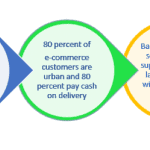COVID-19 Is Accelerating Digital Banking Across the Globe: Here’s How It Will Impact Bangladesh
COVID-19 has changed customer behavior and fast-tracked the adoption of innovative tools and technologies by the global banking sector. For instance, the world has already witnessed a quick increase in customer aversion towards branch-based banking due to pandemic lockdowns. At present, customers are more interested in doing their banking while sitting at home, utilizing digital tools. They now want their banks to enhance their digital offerings, to quicken the evolution from bricks-and-mortar branches to virtual banking services.
This evolution is happening around the world, as banks have been shutting down or adapting branches substantially since the coronavirus pandemic went global in March. Citigroup closed almost 100 branches early on in the crisis, and JPMorgan Chase, the largest bank in the U.S., closed about 1000 branches (temporarily) in its initial response to the pandemic. Meanwhile, U.S. Bank has introduced new branch formats for the digital age: Its new metro-area branches have been provisioned with no teller lines, a cafe area with coffee, snacks and cold beverages, and bank officials who provide instantaneous individual, interactive advice when customers walk in the door. Similarly, Credit Suisse is ready to unveil a challenger bank (i.e.: an all-digital bank offering a full slate of retail banking services). The bank is also cutting down its number of branches across Switzerland, and is transforming others into a “Digital Bar” concept. This new branch model will feature co-working spaces, multimedia group rooms and an event zone at certain locations. Credit Suisse is also offering a new service, CSX and CSX Young (for customers aged 12-25), which is aiming to meet all of its clients’ banking needs by smartphone.
Bank branches are going to persist – but with a redefined role, and a new way of interacting with customers. The coronavirus pandemic has set the sector firmly on the road to digital adoption. A branch network is still necessary to ensure a more meaningful engagement with large corporate and micro, small and medium-sized enterprise (MSME) customers seeking higher-value and wider varieties of banking transactions. But now the burning question is: How will branches and digital banking platforms co-exist?
Banks will transform to reflect how people work, play and live
The global financial sector will need to answer that question while navigating another major shift, which will be centered on changes in the consumer behaviors of the Millennial and Generation Z demographics. Behavioral researchers have shown that these generations of digital natives interact with technology very differently than previous generations. They have an increased expectation of personalization and convenience in their digital experiences, as easy access to mobile technology has made social media an integral part of their daily lives. For that reason, virtual relationship development has become a new generational standard. Even though a large percentage of the Generation Z market is still too young to have bank accounts, they are already aware of mobile payment apps like Google Pay, PayPal, Alipay, Paytm, bKash and M-Pesa, making them less dependent on conventional banks and more open to services delivered by fintechs.
Recognizing these trends, Asia Pacific countries like Hong Kong and Taiwan have introduced a number of digital banks in recent years. Ant Bank, a subsidiary bank listed under Ant Financial, and Mox Bank by Standard Chartered (in partnership with PCCW, HKT and Trip.com) are two notable examples. Similarly, the Monetary Authority of Singapore decided last year to issue up to five digital bank licenses, including two digital full bank licenses and three wholesale bank licenses. These digital banks are to be in operation by the middle of 2021. Likewise, Bank Negara Malaysia is also planning to accommodate up to five new digital banking licenses. Two potential nominees include Boost, a mobile e-wallet powered by Axiata Digital Services, and Grab, a Singaporean technology platform for ride-hailing, food delivery and payment services.
Popular features of digital banks
Digital banking platforms can offer several key advantages over traditional branch-based banking. Let’s take a look at several of their more popular features:
- They allow for the segregation of accounts into sub-accounts, which is popular among users due to its efficiency in managing different incoming and outgoing payment flows. These sub-accounts enable the allocation of multiple savings pots, which allows users to direct their money toward different savings goals, from groceries, car maintenance and eating out, to home ownership or rent.
- They provide money management tools that allow users to easily manage their spending, saving and bill payments.
- They allow quick and simple user log-in by tapping a “magic” link without keying in a password. (So there’s no need to remember a password or type it in accurately, and less concern that a password might be stolen.)
- They offer instant microloans, to meet the sudden need for credit for emergencies and big purchases.
- Their automatic bill payments feature allows customers to pay bills directly from different accounts.
- They provide clear communication on fees and product offerings, with no hidden costs.
- They offer digital stock trading for fast, online transactions and trading options.
- They provide good foreign exchange rates and fast international money transfers.
- Their in-app security features (such as face/fingerprint ID) are more trustworthy than typical online transaction security features.
- They deliver customer service via convenient digital channels like Facebook and Twitter.
- They embrace chatbots, which are experiencing increased demand and adoption in banking, empowering customers with seamless self-service.
- They allow customers to manage all their finances in one place, and to connect to other bank accounts through open banking.
- Their user interfaces have an intuitive, customer-centric design.
- They offer credit cards with an optional debit function. They offer features like “round-ups,” which automatically save the spare change on any purchase into a pot, serving as a digital piggy bank.
- They also offer other features like account lock and unlock, automatic payments and online credit limit and transaction limit increases.
The five key advantages of digital banking in Bangladesh
In light of these advantages – and of the central bank’s efforts to leverage digital technology to improve domestic and foreign remittances, increase uptake of payments and ensure financial wellness among last-mile citizens – it’s worth exploring the potential of digital banking in Bangladesh. (This topic is top-of-mind at Bank Asia, where I serve as a senior vice president, as we have recently applied to the central bank to establish the country’s first digital bank, which we hope will help citizens advance toward better financial health.)
Efforts to establish digital banking in the country may include either digital banks or “neobanks,” which sometimes function with parallel features and functionalities. Digital banks are the online-only subsidiaries of any established and well-regulated bank, whereas neobanks run purely online without any physical branches, existing either independently or in a partnership between a non-banking service provider and a traditional bank. There are also several differences between the neobank and digital bank models in terms of operation, ownership structure and regulatory oversight perspectives. Due to these factors, the best path forward may be to combine the agility of tech companies and the efficient risk management of banking institutions into a new digital bank model suitable for the bank-led Bangladeshi market. This model would have the following advantages:
It would challenge legacy business models: A new digital bank would better serve the unbanked by avoiding the current legacy structures of banking, which are driven by human intervention in activities like Know-Your-Customer processes, credit scoring, loan recovery, etc. As a result, it would reduce operating costs and poor credit decisions, allowing for lower lending interest rates. While the legacy banking system is struggling to improve customer experience and attract a new generation of the urban and semi-urban middle class to the bank branch, a digital banking model would build the entire service experience from the ground up, keeping customer experience at the core.
It would use customer insights and data to design solutions: Digital banks would maintain a proper consumer protection framework, following the best practices established by the best-managed traditional banks. Their extensive use of data and behavioral insights from various relevant sources would allow them to know their customers better, and ensure that risks are closely managed across the organization and at every touch point. As per the country overview report by GSMA in 2018, Bangladesh is the ninth-largest mobile market in the world with a unique subscriber base of 85 million, and a 51% penetration rate that increased to 54% in 2019 and is projected to reach 60% by 2025. Big data analytics driven by the combination of telco and mobile financial services data offers a tremendous opportunity for digital credit scoring of the country’s base of the pyramid customers.
It would collaborate with incumbent fintechs: Digital banking would open a new window of opportunities for local Bangladeshi tech entrepreneurs to step up to the next level of financial industry partnerships. There are a number of local tech companies that are already serving different banks, microfinance institutions and non-banking financial institutions with their technology solutions. Digital banking would create an enabling environment for these local tech entrepreneurs to expand these partnerships, and to tie up with various international fintechs to jointly serve the market.
It would enable new business models and foreign direct investments (FDIs): Digital banking would facilitate market linkages to global business actors and funders. First-hand small tech startups would provide solutions for big banks’ glitches and inefficiencies, in collaboration with international fintechs. Bangladesh is currently facing a declining trend in foreign direct investment. Digital banking will be able to attract many strategic partners with sizable fresh investments from different international markets, to stimulate the country’s FDI situation in the post-COVID-19 world.
It would lead to more affordable and convenient solutions for the country’s large un(der) banked segments: Considering the current landscape of digital financial services in Bangladesh, digital banking would likely create an enabling regulatory as well as market environment for broader, deeper and leaner savings and credit products. This would help transition customers from mainly using over-the-counter money transfers to developing greater financial health through a variety of digital savings and credit products designed for their unique needs.
Consumers around the world are beginning to expect their banks to function more like technology companies. How banks can navigate these changing customer expectations will be a burning question for the industry, as the pandemic crisis continues and eventually subsides. But though banks will have the opportunity to capitalize on the improvements in safety and cost-efficiency provided by digital banking, the true value of digitalization lies in its benefits to consumers. Throughout the world, from Europe to South America and the Asia Pacific, an evolving banking model is blending the artificial intelligence, blockchain technology, cloud computing and data analytics-driven models pioneered by fintechs to change the face of banking. South Asia is no exception, and digital banking will bring this new model to Bangladesh and its 166 million+ mobile phone subscribers and 108 million+ internet subscribers, delivering banking services across the country – without the limitations of the traditional brick-and-mortar branch banking model.
Jakirul Islam is a Senior Vice President of Bank Asia.
Photo credit: WorldFish
- Categories
- Coronavirus, Finance, Technology



